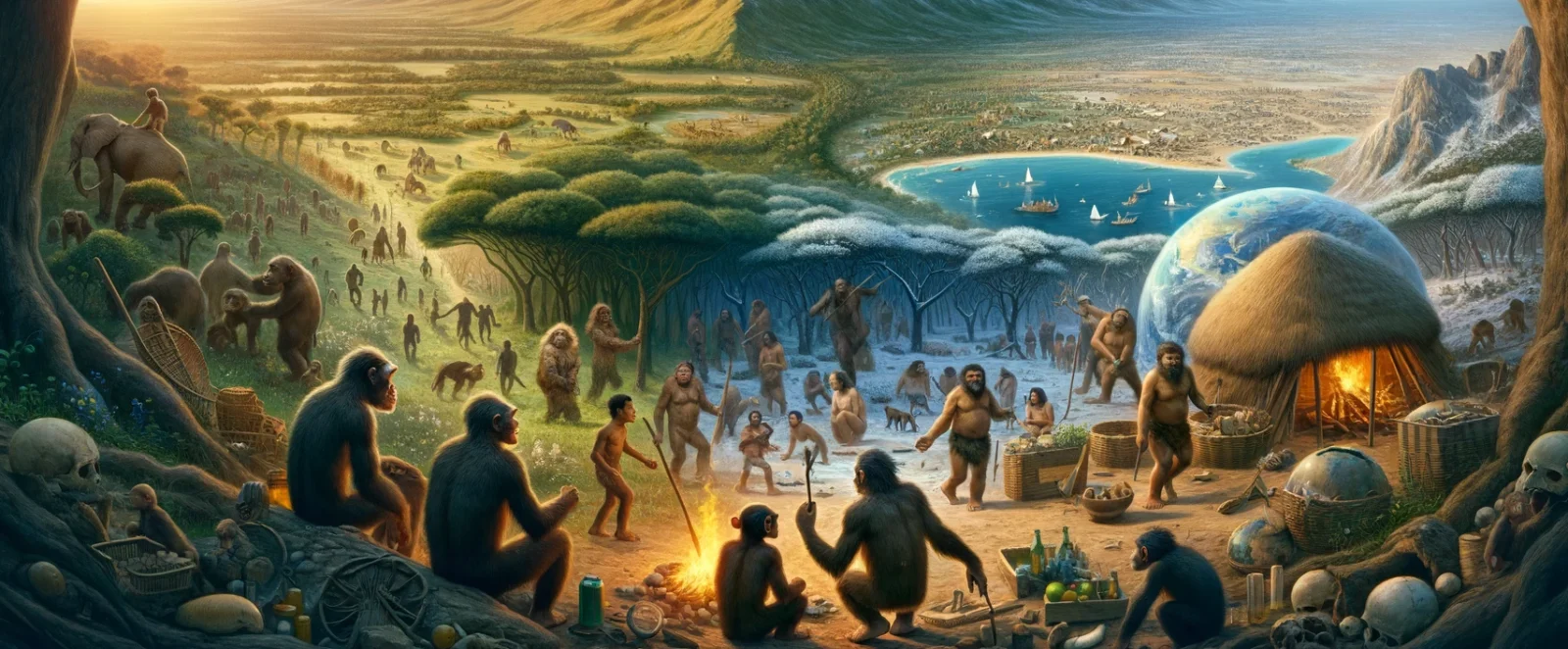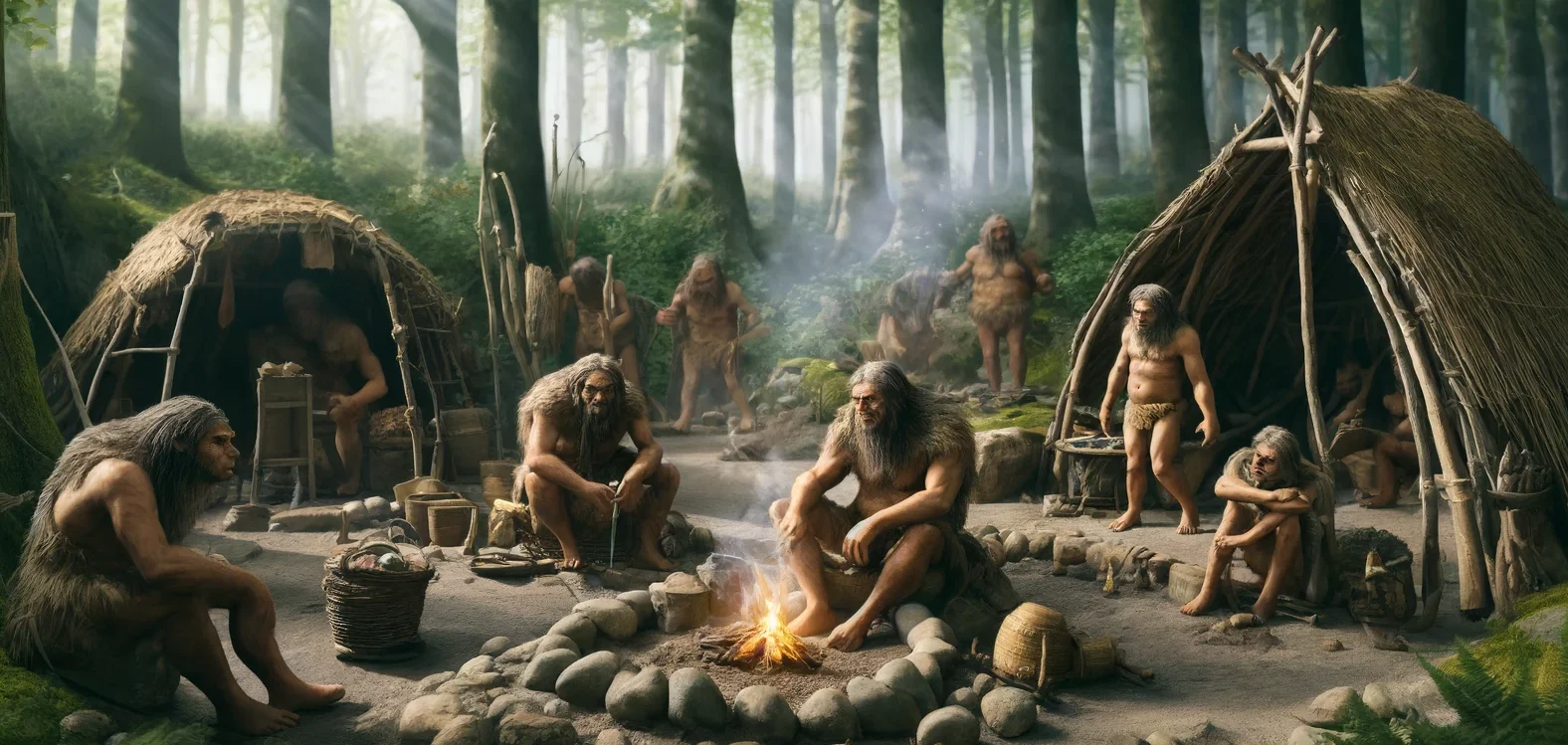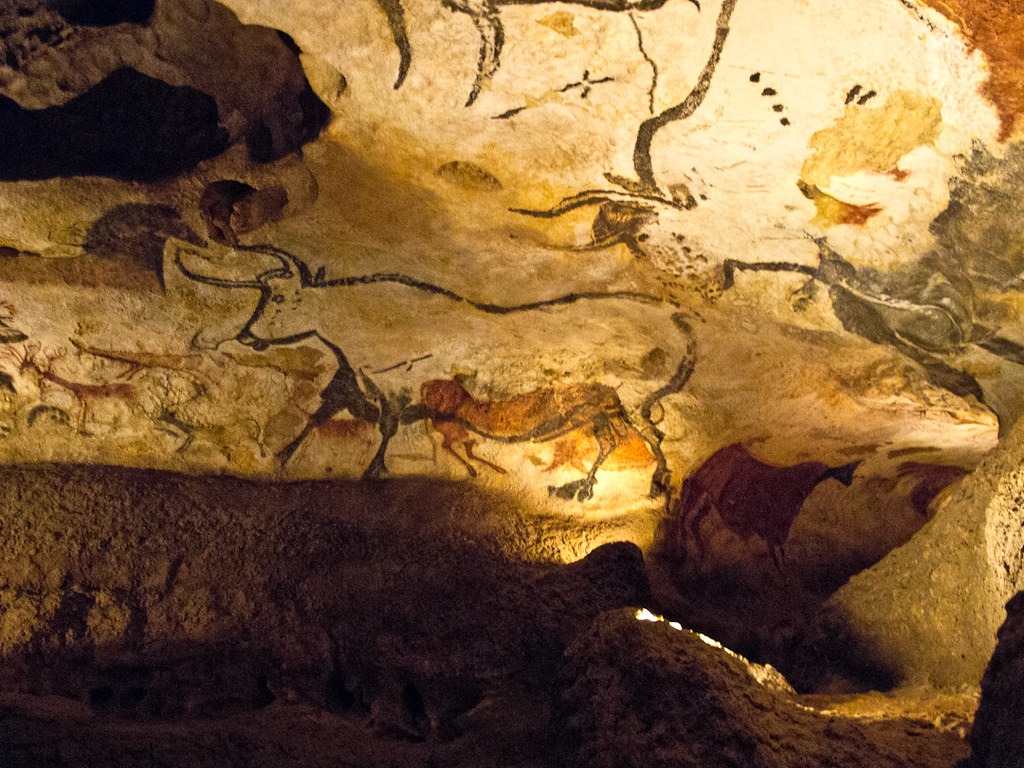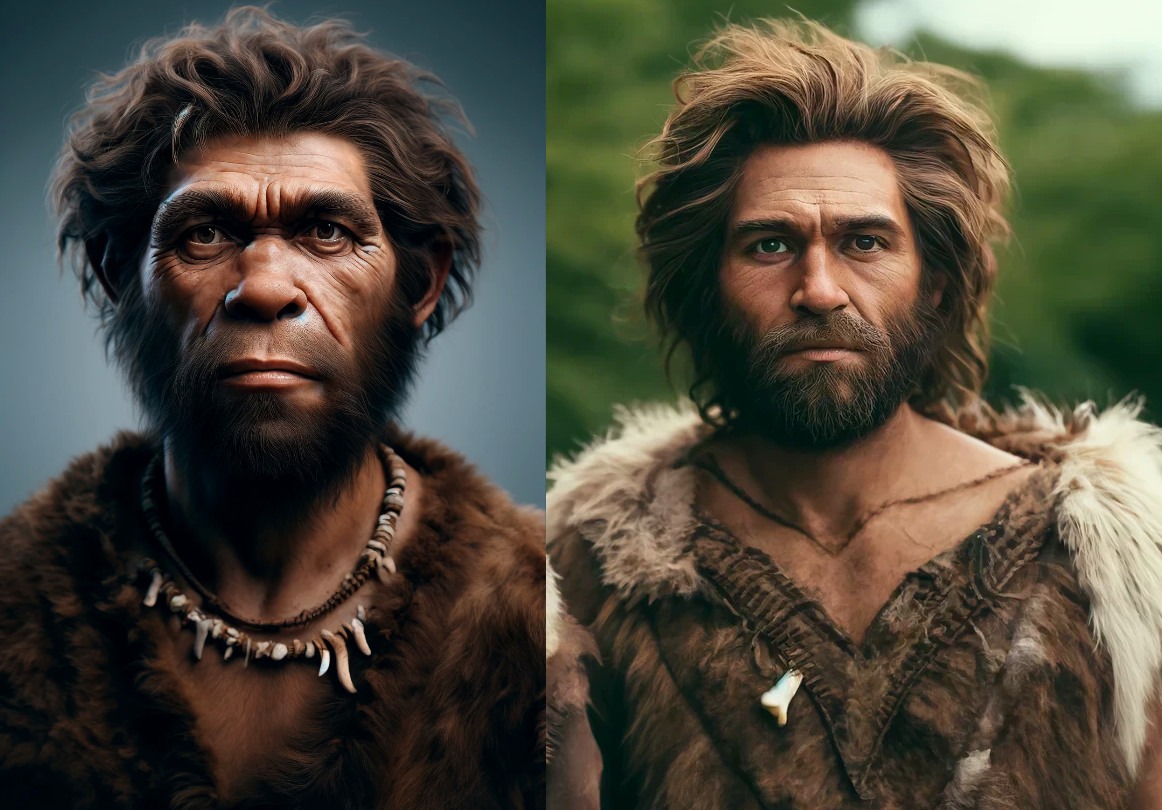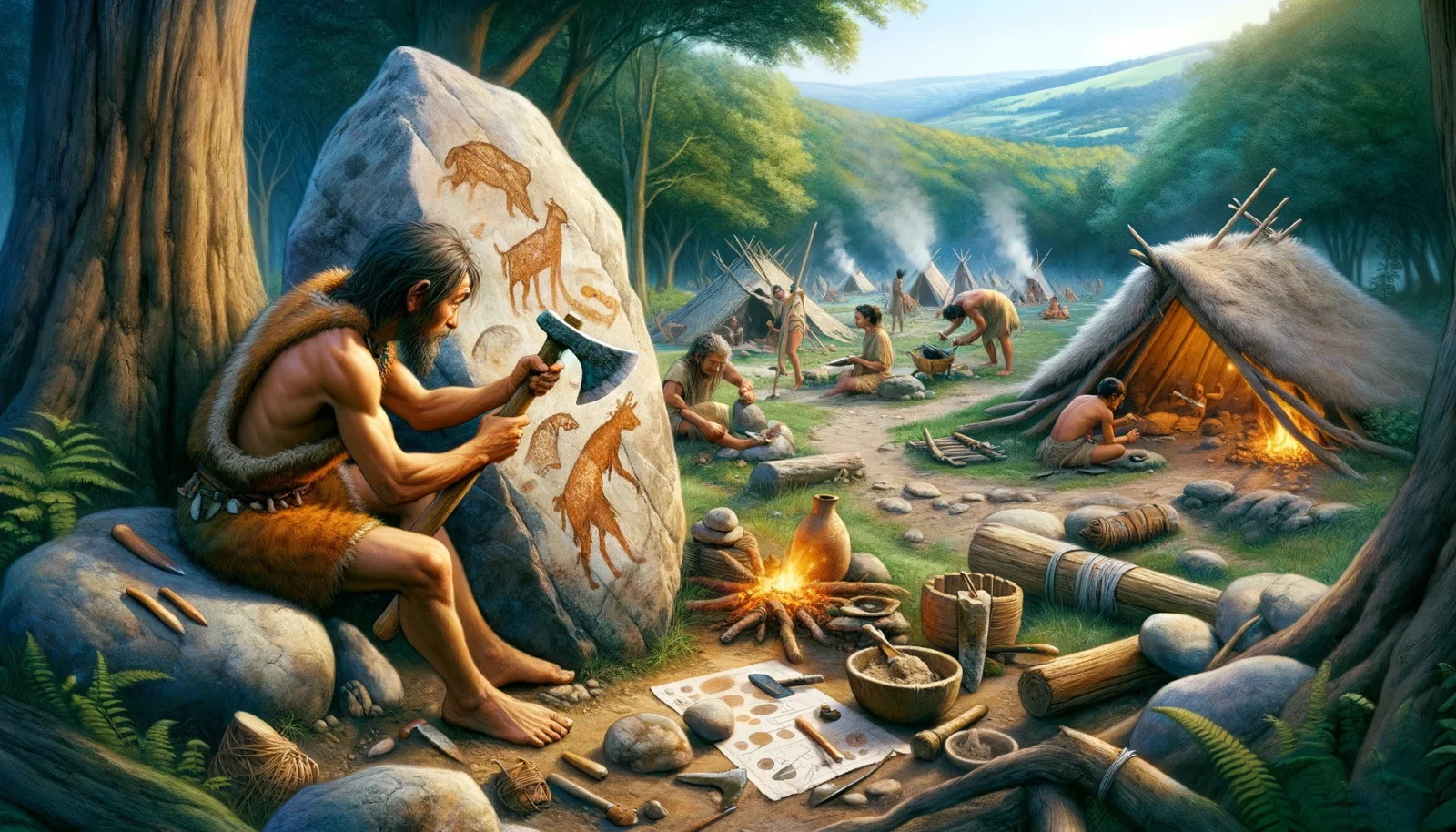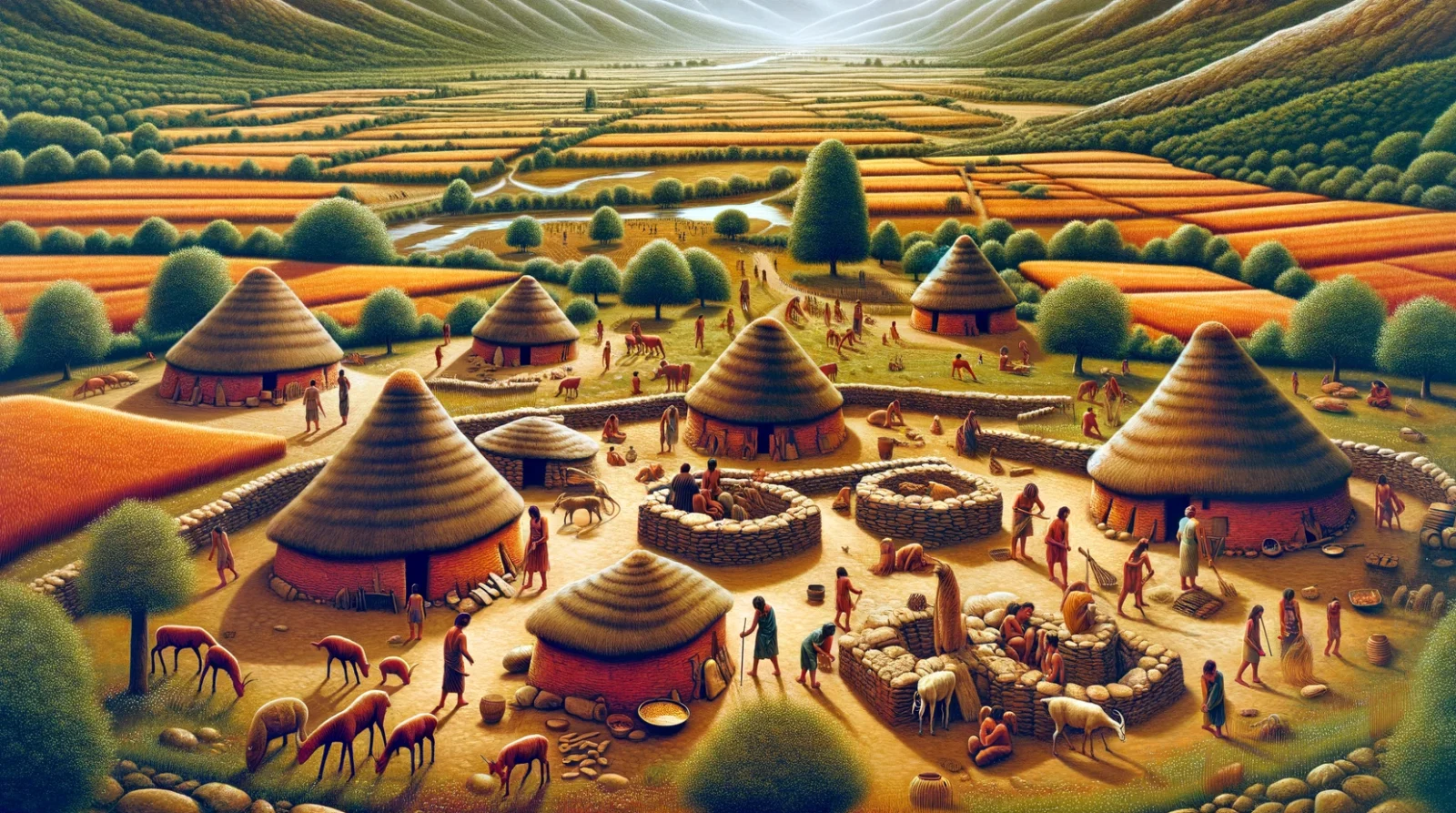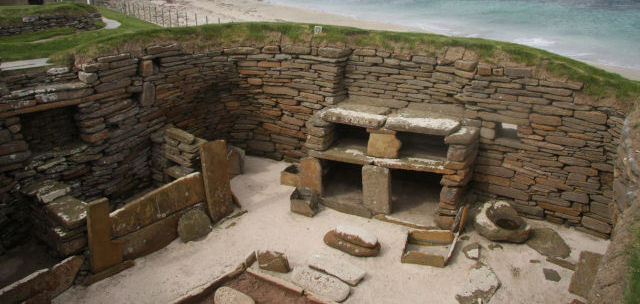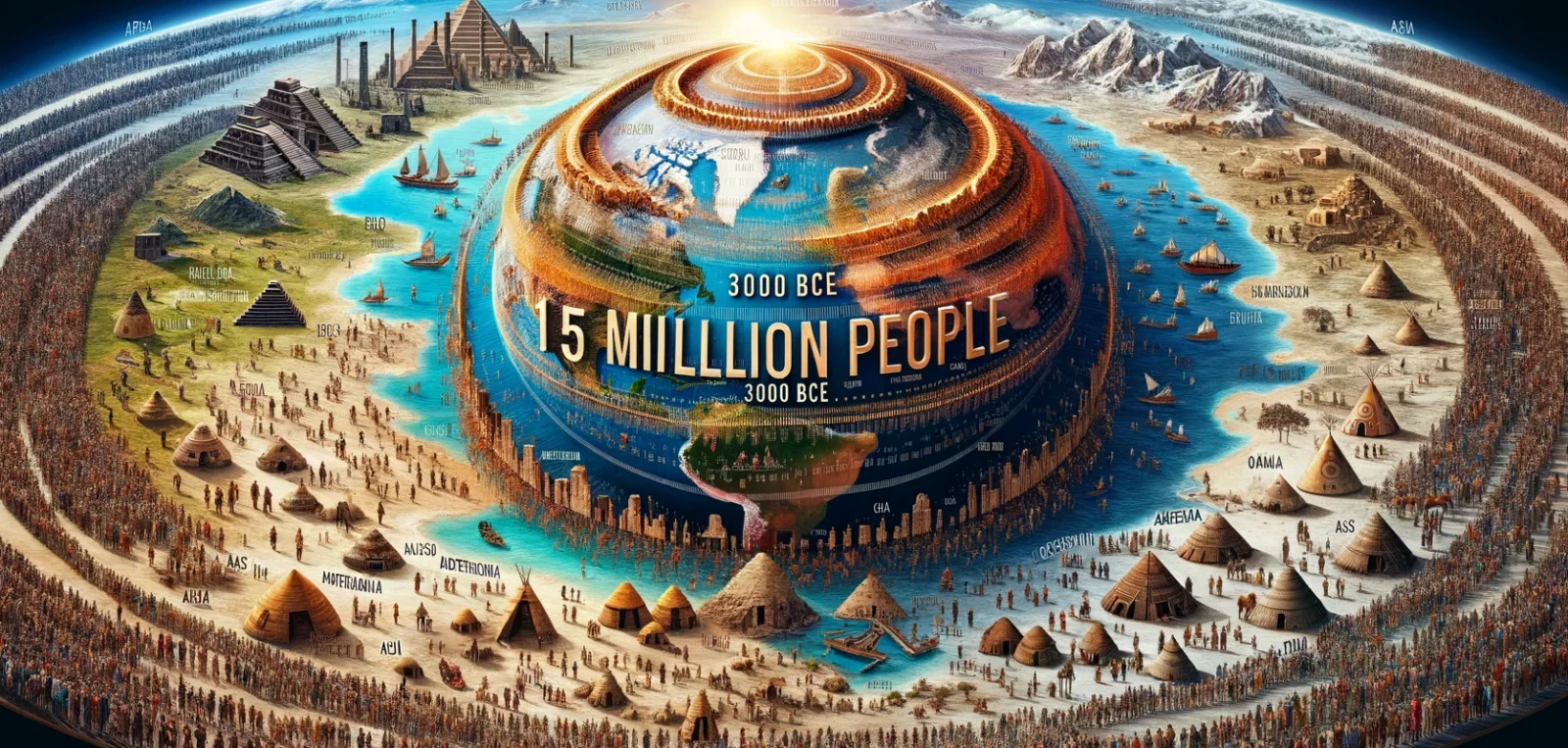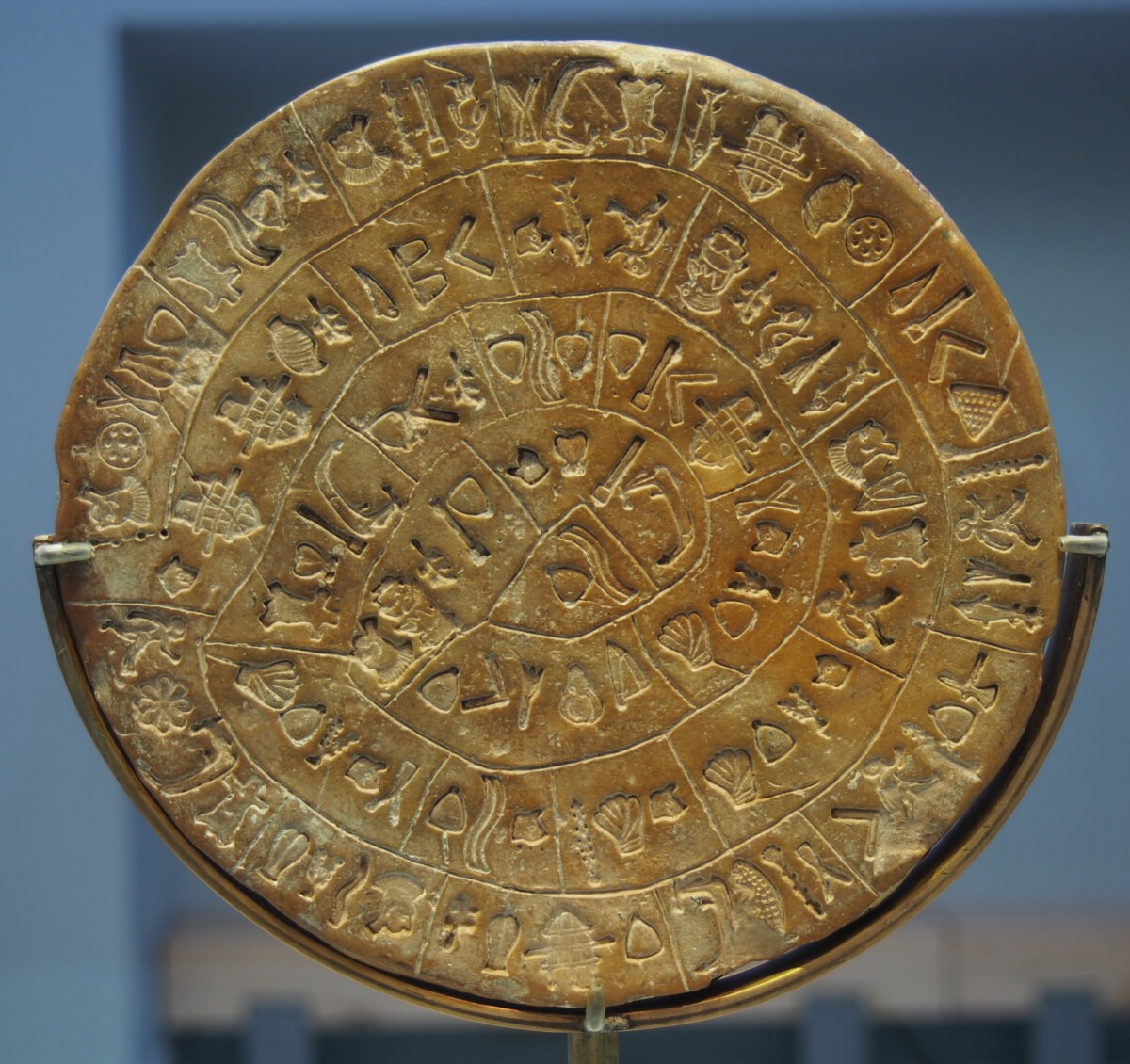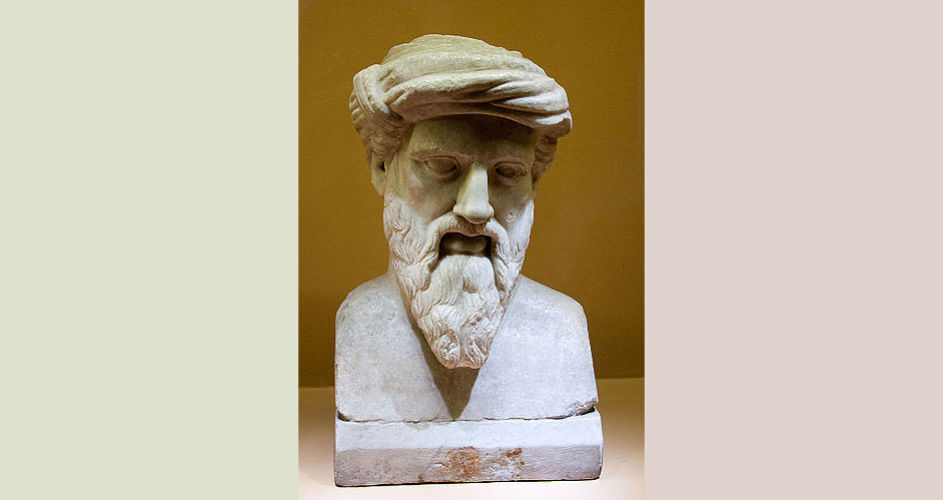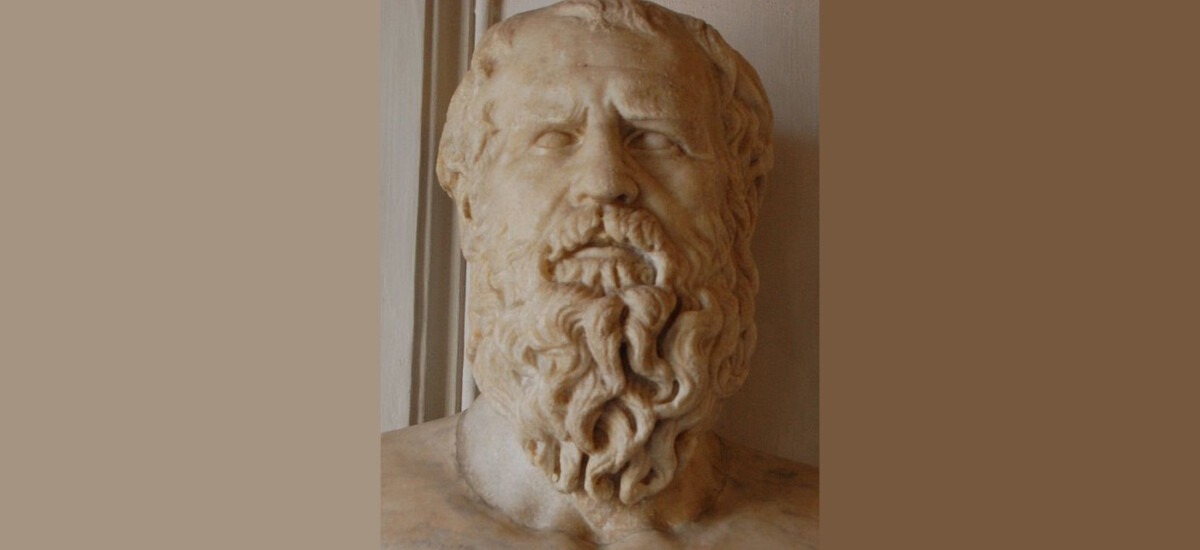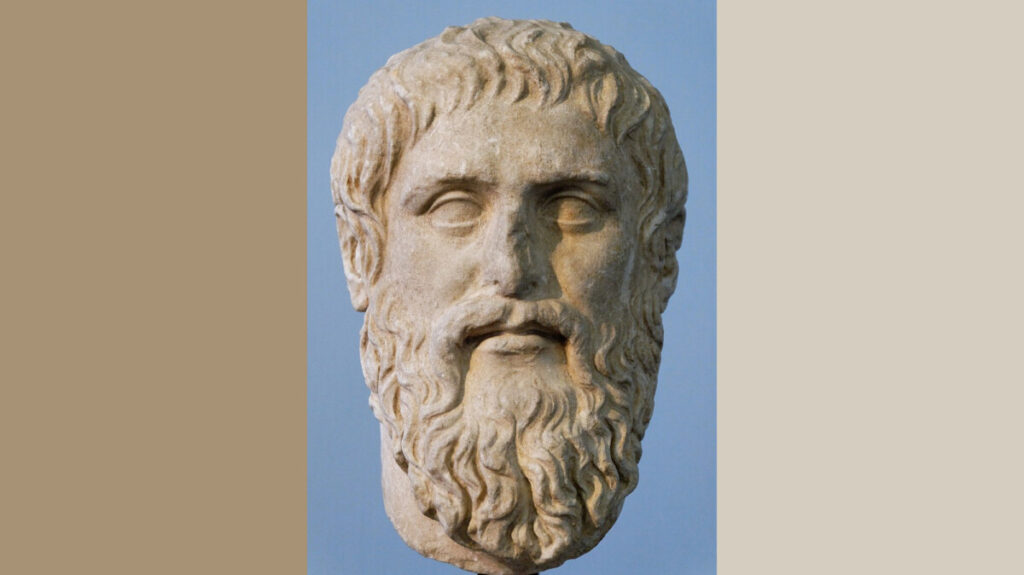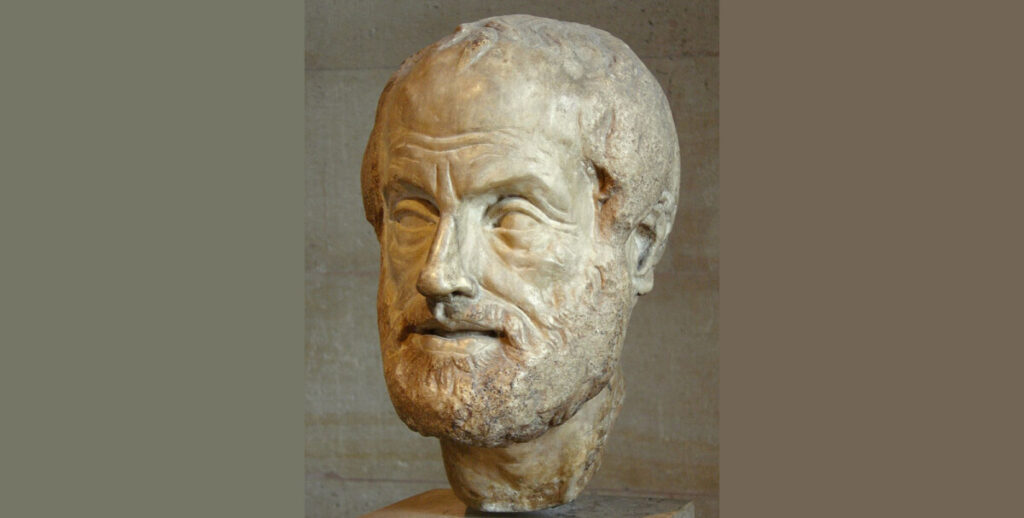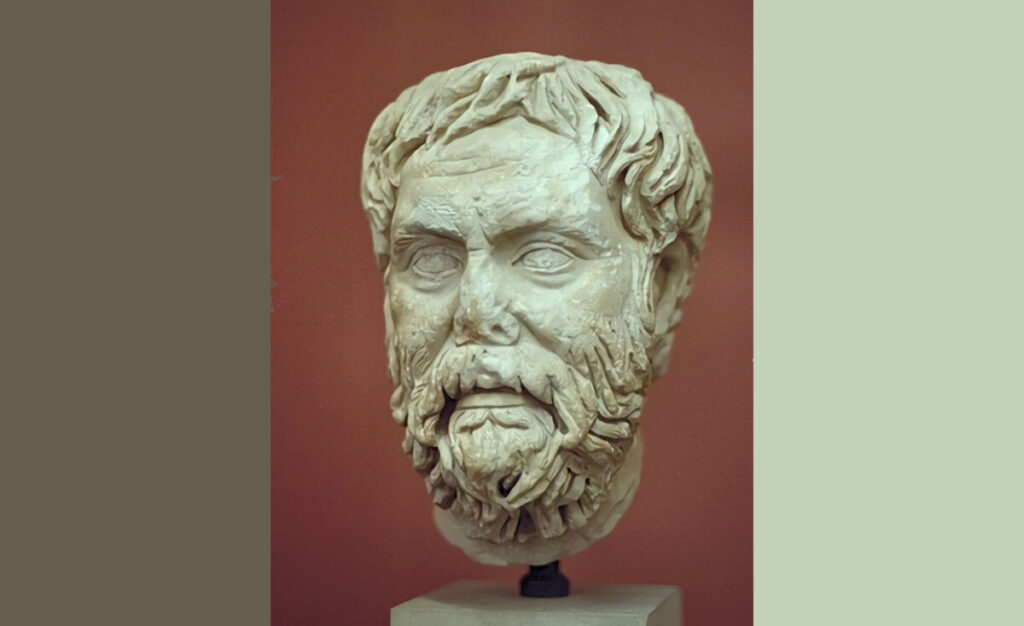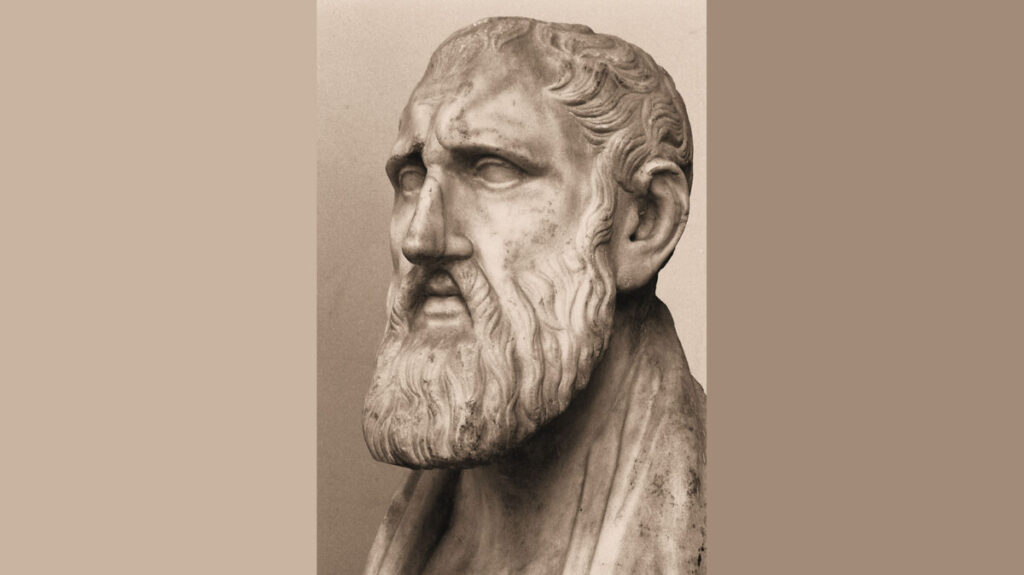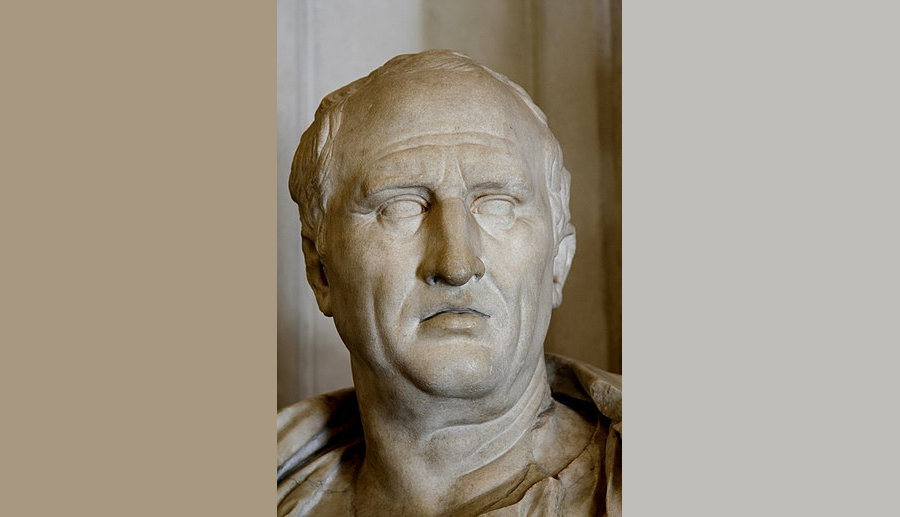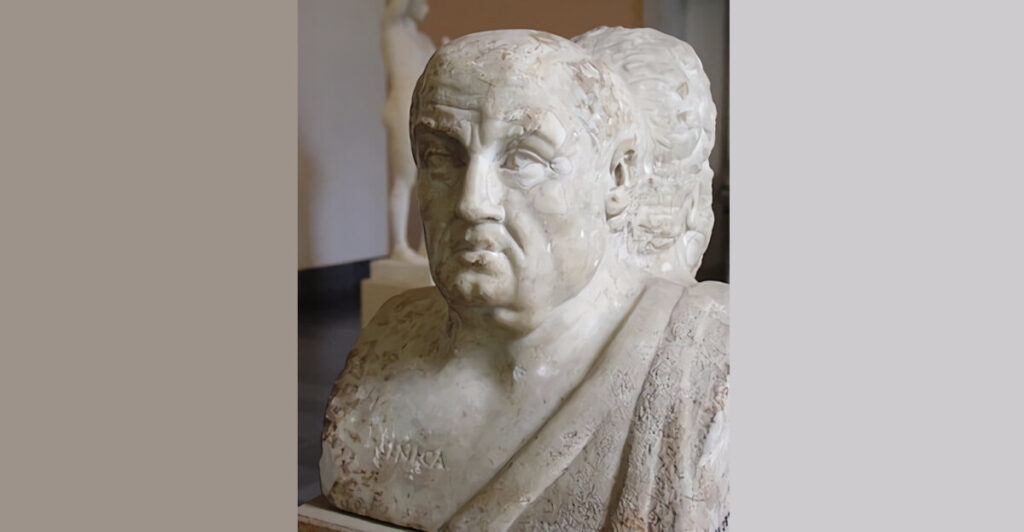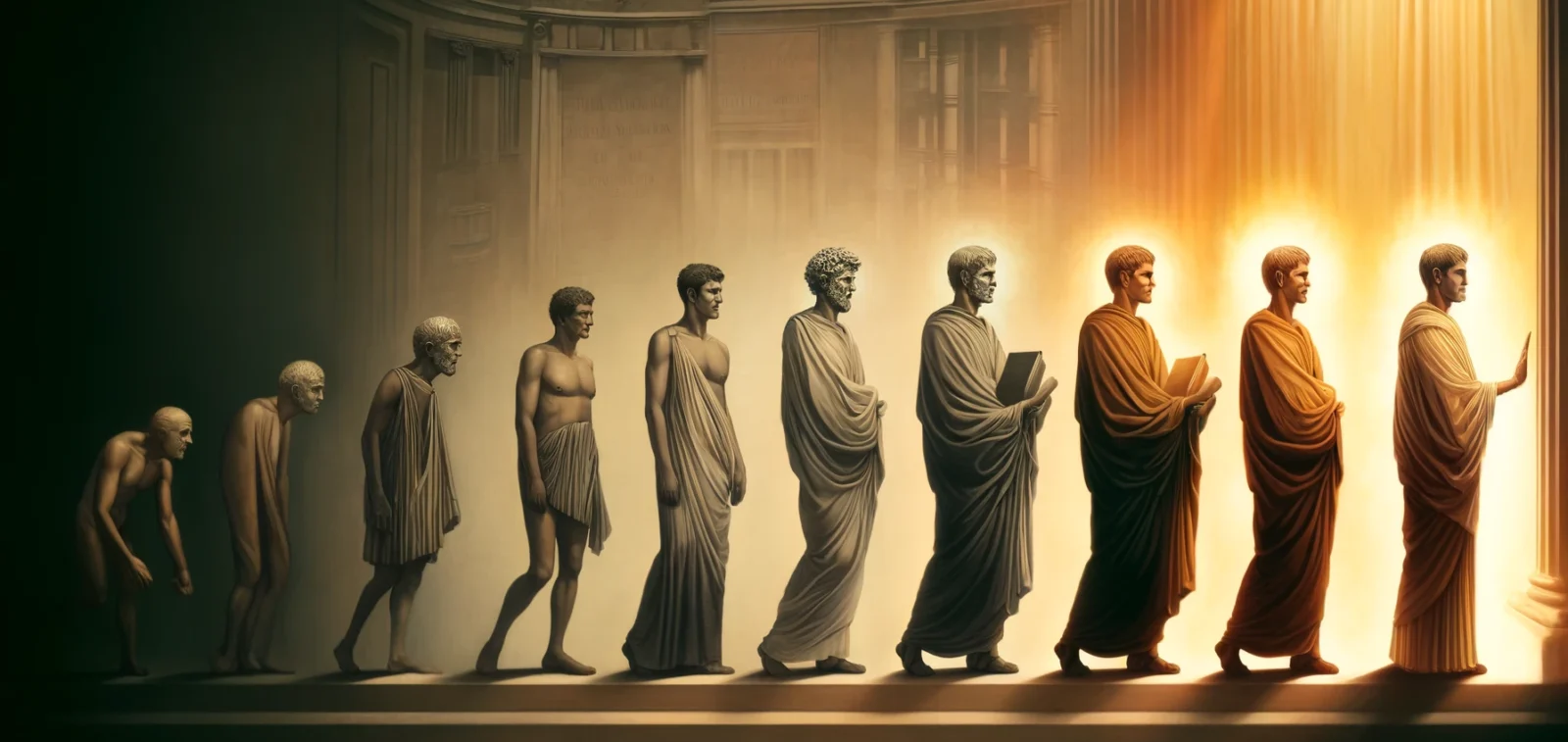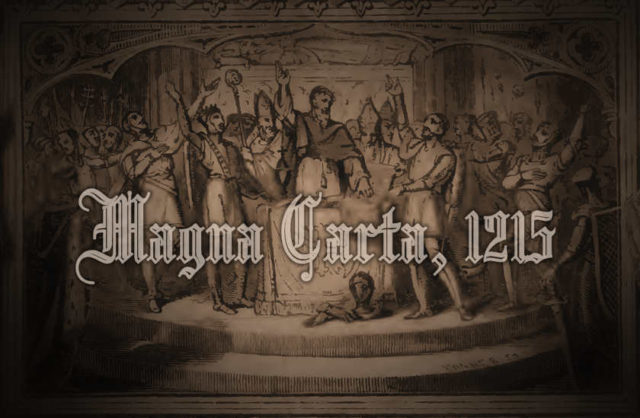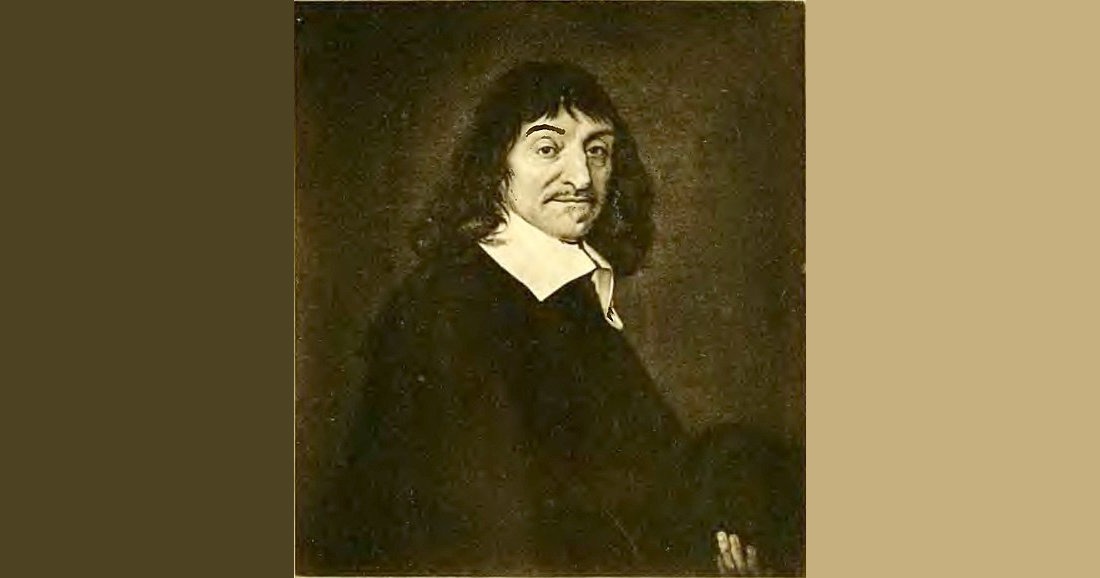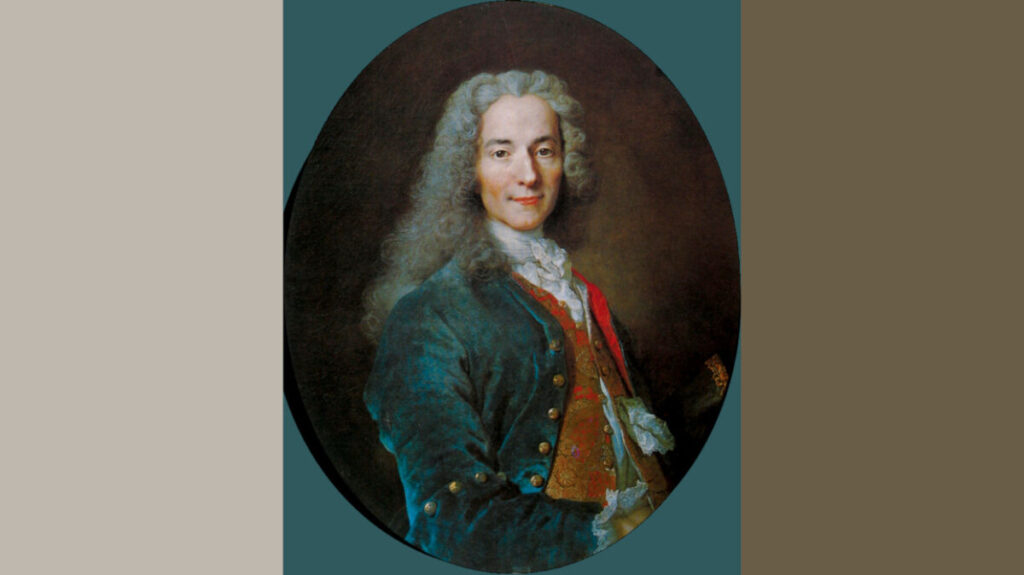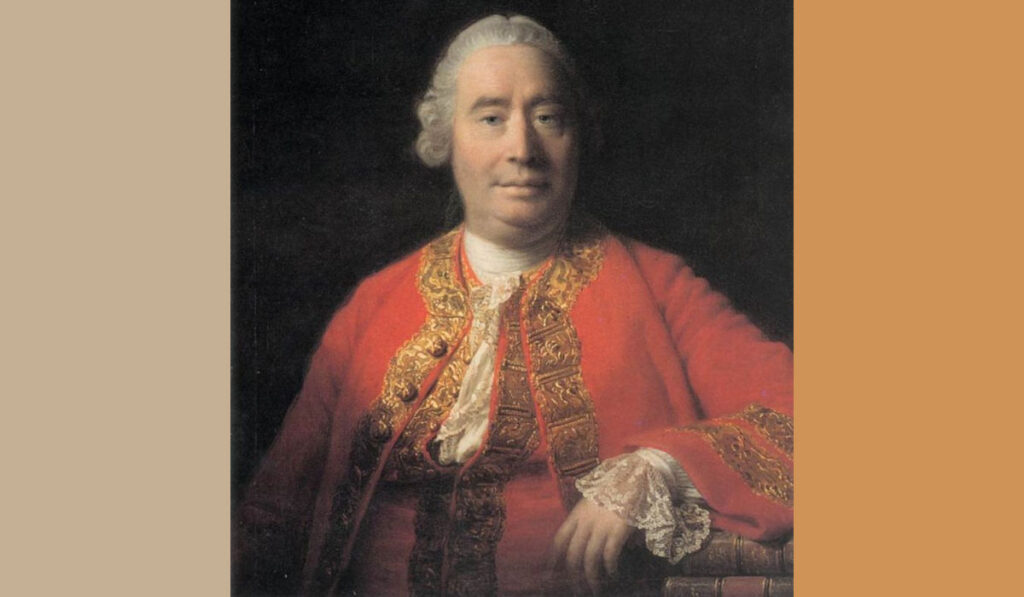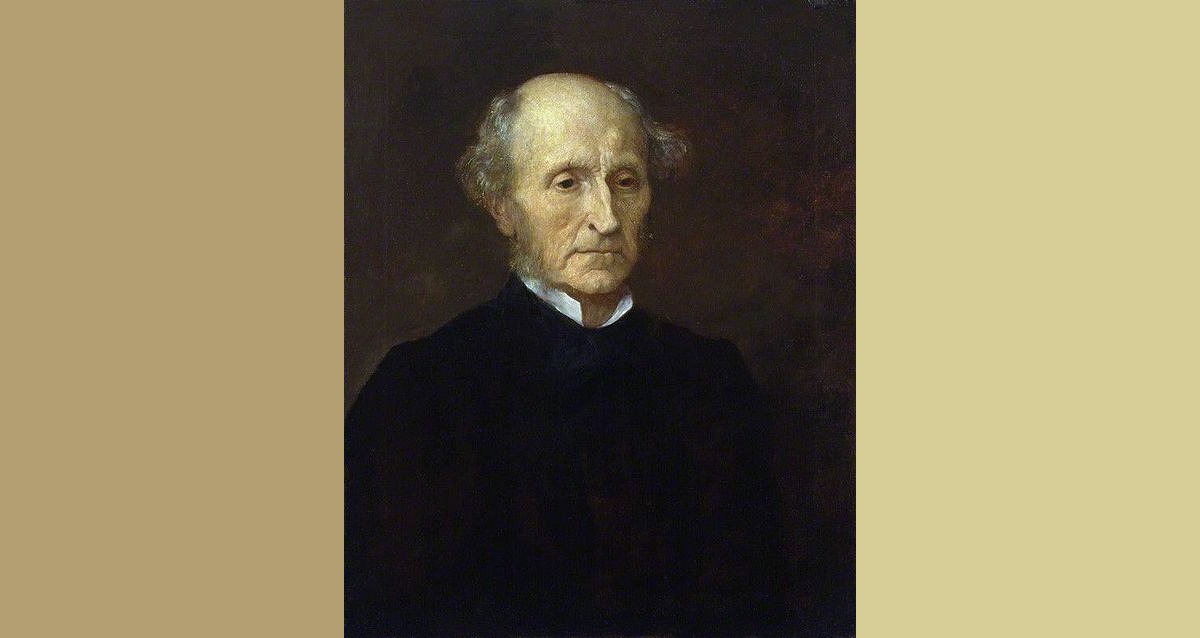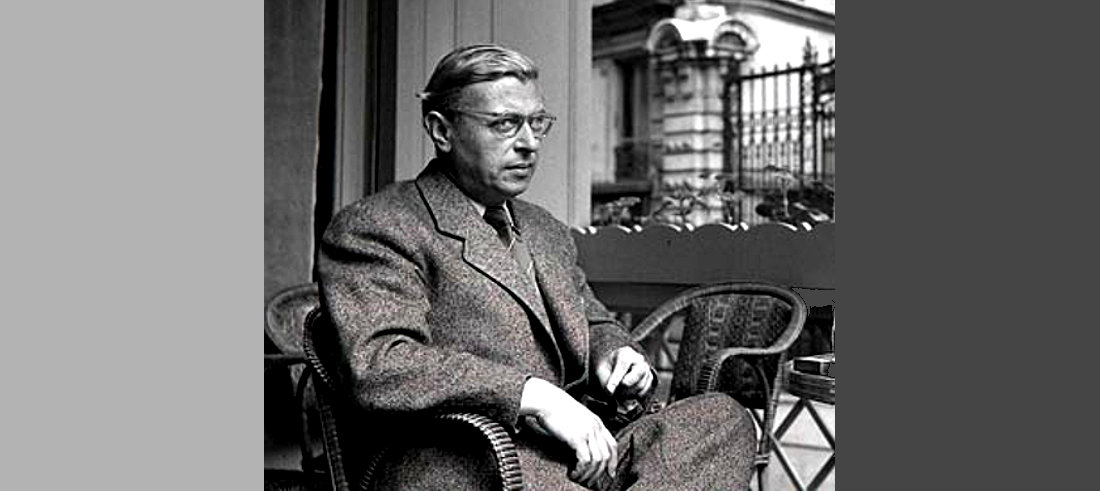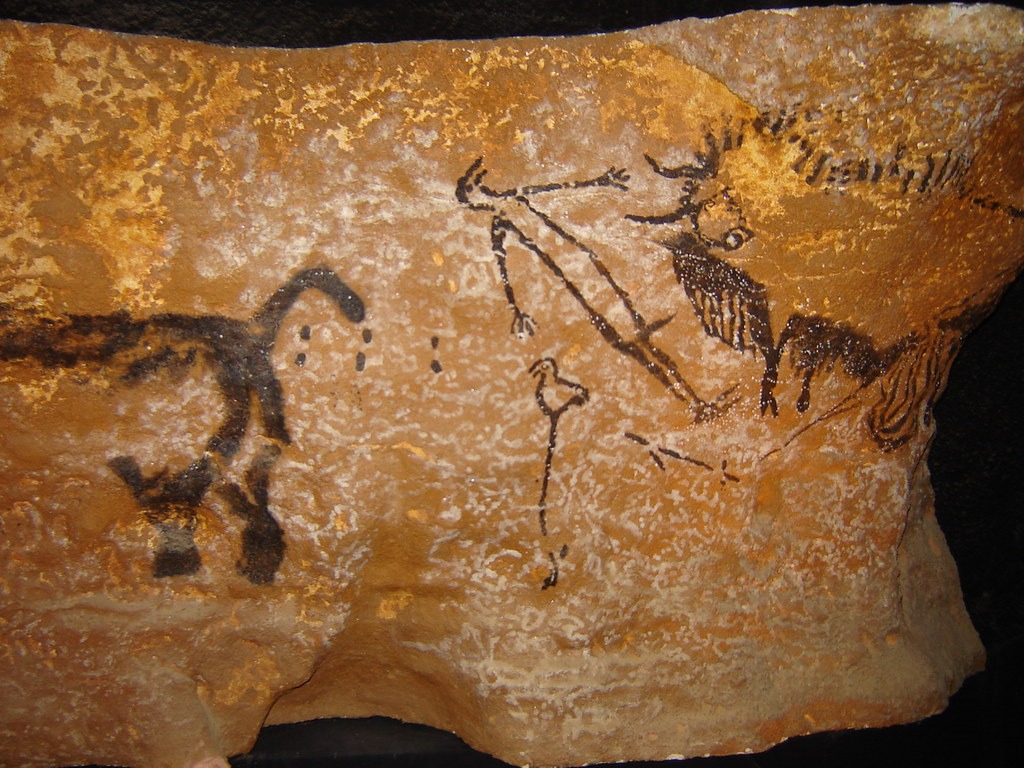Land TL: 1. Africa & Middle East | 2. The Americas | 3. Asia | 4. Europe-Mediterranean | 5. Oceana-Australasia
History by historical land mass is yet another wonderful lens into knowledge. These insights are the backbone to Mike‘s articles and his longer effort books. A part of his lifelong commitment to study. While they are not complete, they are useful.
History of the Lands: Europe
Discovered in the 1990s, this 400,000-year-old Homo heidelbergensis structure in France is believed to be a primitive hut or shelter made from wooden posts and branches. The structure is thought to have been built by Homo heidelbergensis. The shelter is estimated to be around 4-5 meters (13-16 feet) wide and 6-7 meters (20-23 feet) long. It’s believed to have been constructed using a simple framework of wooden posts, with branches and leaves used to create a roof and walls. While the above image is a minimalist artist representation, the following is more likely what their camp looked like.

When Homo sapiens first emerged, their population in Africa was likely just a few hundred thousand, while the total hominin population, including other species like Neanderthals and Homo heidelbergensis, may have ranged from 1.1 to 2.1 million. During this period, Homo sapiens were primarily found in Africa, while other hominins occupied broader ranges across Eurasia, with Neanderthals and Denisovans adapting to their environments with sophisticated tool-use and social structures. The early hominin distribution and interaction remain unclear, and this narrative, while speculative, helps us imagine the ancient world, highlighting the need for caution in interpreting these ancient population dynamics. Check out A New Look at Ancient Hominin Numbers: A Speculative Journey for more information.
Homo heidelbergensis lived in Africa, Europe and Asia from 700,000 to 200,000 years ago. They coexisted with humans in Africa, Europe, and Asia from our emergence around 315,000 years ago until their extinction about 200,000 years ago.
Imagined Image: A Homo heidelbergensis campsite a few thousand years before they went extinct, set in a lush European forest. The scene includes several individuals in a communal setting, showcasing aspects of their life and environment.
Cognitive Revolution
50,000 BCE – 70,000 BCE. Population range: 500,000 to 2.5 million.
Given the uncertainties and lack of direct data, the following are speculative estimates.
- Africa-Middle East: 50-60% or 600,000 to 1 million people
Africa, being the origin of modern humans, likely had the highest population density at this time, particularly in Sub-Saharan regions which were more conducive to human habitation due to their climate and available resources. - Asia: 40% or 200,000 to 400,000 people
- Europe-Mediterranean: 10% or 50,000 to 100,000 people
- The Americas: 0.
- Oceana-Australasia: 1% or 10,000 to 15,000 people
The initial colonization of Australia around 50,000 BCE by modern humans involved small, isolated groups who managed to navigate sea crossings, leading to a very low initial population density. The rest of the remote islands of Oceania were among the last to be reached by humans.
A Shared Earth! Neanderthals-Hobbits-Flourensis
Around this time, Homo sapiens shared the Earth with other hominin species. Neanderthals were still widespread in Europe and parts of western Asia. In Asia, particularly on the islands of Indonesia, Homo floresiensis, often referred to as the “Hobbit” due to their diminutive stature, survived until about 50,000 years ago. Additionally, Denisovans, a less visually documented but genetically distinct group, also roamed Eurasia, leaving behind a genetic legacy that persists in modern humans, particularly among populations in Melanesia.
Earliest known symbol use in the Europe/Mediterranean zone.
Dating back to around 40,000 BCE, the Upper Paleolithic cave art found across Europe presents a compelling narrative of early human communication and symbolic expression. Sites like Lascaux in France and Altamira in Spain feature elaborate depictions of animals, human figures, and abstract symbols that recur with remarkable consistency across diverse regions. These symbols, including dots, lines, and geometric shapes, suggest a standardized usage that transcends mere artistic decoration. Researchers speculate that these symbols may have served proto-writing functions, possibly representing early attempts to record important information such as seasonal changes, ritual practices, or social codes.
The oldest undisputed musical instrument is the Hohle Fels Flute discovered in the Hohle Fels cave in Germany’s Swabian Alb in 2008. The flute is made from a vulture’s wing bone perforated with five finger holes.
Homo neanderthalensis: Neanderthals and humans coexisted in Europe and Asia until around 40,000 years ago. While their exact cause of extinction remains debated, competition with modern humans and climate change are thought to be contributing factors.
Imagined image: Left is a neanderthal, right a human. Just as human looks vary widely, Neanderthals did too. This is perhaps one way neanderthals might have looked. The likely looked a bit more human than this too, but this gives you a good idea of the differences.
Current understanding suggests that the diverse skin colors among modern humans, ranging from dark brown to fair, evolved multiple times both within Africa and as Homo sapiens migrated out of Africa. This variation is driven by natural adaptation to varying levels of UV radiation exposure in different populations, a process that typically unfolds over thousands of years.
Modern humans predominantly descend from a successful migration wave out of Africa that occurred around 50,000 years ago. Although there were earlier migratory events, this later exodus has been well-documented and significantly shaped our genetic makeup. Evidence suggests that these migrants interbred with earlier waves of sapiens as well as other hominin groups they encountered, notably including Neanderthals and Denisovans.
Skin color adaptation occurred in each migratory wave of Homo sapiens, as well as through interactions with other hominins. The process that most significantly affected modern skin colors began during these migrations and continued over a span of 20 to 30 thousand years. Cross-breeding among various waves of populations, which contributed to the diversity in skin pigmentation, was almost certainly a factor. Lighter skin tones primarily evolved in areas with reduced sunlight, especially after the Last Glacial Maximum, to facilitate vitamin D synthesis under conditions of lower UV radiation.
Note: The adaptation of skin color is intricately linked to the migration patterns of ancient humans. As populations spread from Africa into Europe, the Mediterranean, the Middle East, and Asia, their skin color adapted to local environmental conditions. Robust genetic evidence, particularly concerning alleles such as those in the SLC24A5 and SLC45A2 genes, supports these adaptations. This evolutionary trajectory underscores the complex interplay between genetics, diet, and environment in shaping one of the most visible aspects of human diversity.
Earliest known seasonal settlement in the European Mediterean zone: Nestled in the Argolid region of the Peloponnese in Greece, the Franchthi Cave offers a unique window into the lives of early Europeans spanning from the Upper Paleolithic through the Mesolithic and into the Neolithic periods. For over 23,000 years, from about 20,000 BCE to 3,000 BCE, this cave served as a seasonal hub for prehistoric communities.
The strategic coastal location of the Franchthi Cave allowed early humans to exploit both marine and terrestrial resources effectively. The abundance of marine shells and fish bones found within the cave layers suggests that these groups were highly adept at fishing and shellfish gathering, activities that likely formed a significant part of their subsistence strategy during their stays.
As seasons turned, these early inhabitants would have utilized the cave as a base from which to conduct their hunting and gathering activities. Over millennia, the evidence shows a gradual shift from reliance on wild resources to the introduction of domesticated plants and animals, signaling the start of agricultural practices in the region.
This transition marks Franchthi Cave not just as a site of temporary habitation but as a pivotal location where significant cultural and technological transformations occurred. The cave’s extensive use and the layers of habitation offer profound insights into the evolutionary journey of human societies in the Mediterranean, showcasing how a simple seasonal settlement could eventually evolve into a cornerstone of early agrarian life.
Franchthi Cave thus represents one of the earliest known seasonal settlements in the European-Mediterranean zone, providing invaluable lessons on the adaptability and innovation of early human communities in the face of changing environmental and social landscapes.
Imagined image: This image portrays a seasonal settlement at Franchthi Cave around 10,000 BCE, where early humans utilized natural materials to construct temporary shelters nestled within a lush landscape. Central hearth areas serve as communal hubs for cooking and social gatherings, illustrating the strategic use of space and resources by these early inhabitants. The arrangement of shelters around the cave entrance highlights their reliance on the natural environment for survival and community activities.
Eastern Asia and Europe: The domestication of dogs marks one of the most remarkable and earliest examples of animal domestication by humans. This significant event occurred approximately 20,000 years ago, with some studies suggesting an even earlier date. The process began when wolves, drawn by the waste and remnants of hunting left by human groups, started to linger around the fringes of hunter-gatherer camps. Over time, a mutual relationship developed: these ancestral wolves provided humans with alertness to dangers and help in hunting, while humans provided a steady food source.
The transformation from wild wolves to domesticated dogs likely took place in several regions independently, but genetic evidence points to significant early domestication events occurring in Eastern Asia and Europe. Through a natural and then increasingly intentional process of selection, humans favored wolves that exhibited traits beneficial to their lifestyle—traits like reduced fear and aggression, which made them better companions and guards. This led to genetic divergence from their wild counterparts, morphing wolves into various forms and breeds of dogs as we recognize them today.
These early dogs were not just pets but integral to human societies, assisting in hunting, guarding territories, and providing companionship. Their roles expanded as human societies grew more complex, with dogs adapting to various climates and cultural expectations. The domestication of dogs not only highlights the adaptability and intelligence of these animals but also underscores the deep, symbiotic relationship that developed between two distinct species, setting the stage for the later domestication of other animals and the rise of agrarian societies.
The Mezhyrich community thrived in Ukraine, living in huts built from mammoth bones. These resourceful people used mammoth skulls, tusks, and bones to construct shelters covered with animal skins. They engaged in daily activities such as cooking, tool-making, and socializing, showcasing a harmonious, bustling life. The nearby rivers provided resources and sustenance, while their sophisticated structures indicated advanced social organization and cooperation.
Late Stone Age
Mesolithic Period: 10,000 BCE – 6000 BCE.
- Africa-Middle East: 30% or 1.2 million peopleg
- Asia: 40% or 1.6 million people
- Europe-Mediterranean: 15% or 600 thousand people
- The Americas: 10% or 400 thousand people
- Oceana-Australasia: 5% or 200 thousand people
The Neolithic Revolution is the earliest known Agricultural Revolution. It is very likely that humans practiced forms of agriculture earlier. How much earlier? Well, without evidence, we are guessing. For convenience, anthropologists label humans as hunter-gatherers prior to the Neolithic Revolution. The fact is that the current theory states that agriculture started magically all around the world circa 9,700 BCE. I think it is much more likely this is simply the earliest farming we have yet to discover and will likely push this date back further and further over time.
The Neolithic revolution is the belief in a wide-scale transition of many human cultures during the Neolithic period from a lifestyle of hunting and gathering to one of agriculture and settlement, making an increasingly large population possible. These settled communities permitted humans to observe and experiment with plants, learning how they grew and developed. This new knowledge led to the domestication of plants. A stable lifestyle led to more leisure time and more time to think about things which led to what we would call civilization today. Only the most sturdy of structures from this time period survived the test of time.
Blue eyes emerging stands out as a striking example of a genetic mutation that spread across populations. Traced back to a single individual living between 6,000 and 8,000 BCE in the region near the Black Sea. The mutation involved is a specific change in the OCA2 gene, which alters the way melanin is produced in the iris. Originally, all humans had brown eyes, but this mutation led to the reduction of melanin in the iris, resulting in blue eyes.
Earliest known agrarian society in the Europe/Mediterranean zone: The Sesklo culture in Greece is recognized for its early adoption of agriculture, including the cultivation of cereals and legumes, and domestication of animals. This Neolithic culture is noted for its distinctive pottery and advanced housing architecture, reflecting significant societal organization.
Imagined image: The Sesklo Culture village around 7400 BCE, featuring sturdy mud-brick houses with thatched roofs, organized around a communal area, set in a lush, agriculturally rich landscape. This early Neolithic settlement in Greece exemplifies one of Europe’s first transitions to a settled, agrarian lifestyle.
In the Neolithic villages of Poland, milk, a nourishing gift from domesticated animals, is left to curdle, giving rise to the earliest form of cheese.
Skara Brae is a stone-built Neolithic settlement, located on the Bay of Skaill on the west coast of the largest island of Scotland. It consists of ten houses made of flagstones within earthen dams that provided support for the walls; the houses included stone hearths, beds, and cupboards. A primitive sewer system, with “toilets” and drains in each house which carried waste to the ocean using water to flush waste into a drain.
Stone Copper Age
Chalcolithic Period: 3,000 BCE – 500 BCE.
- Africa-Middle East: 36% or 5 million people
Early civilizations include Egypt and Mesopotamia with a relatively higher population density. - Asia: 36% or 5 million people
Early civilizations include Indus Valley and ancient China. They saw early urban development and agriculture which supported larger populations. - Europe-Mediterranean: 14% or 2 million people
Smaller due to the varied climatic conditions and the later development of agriculture compared to the Middle East. - The Americas: 7% or 1 million people
More sparsely populated with many diverse hunter-gatherer communities and early agricultural societies, particularly in regions like Mesoamerica. - Oceana-Australasia: 7% or 1 million people
These regions were among the least densely populated, with scattered tribal groups primarily leading hunter-gatherer lifestyles.
Earliest known writing in the European/Mediterranean zone.
The earliest known writing system in the European/Mediterranean zone is the Cretan Hieroglyphic script from ancient Crete, part of the Minoan civilization. This script dates back to around 1900 BC to 1700 BC. Closely related and slightly later in development is Linear A, which emerged around 1800 BC and was also used by the Minoans.
These scripts were used primarily on the island of Crete and remain largely undeciphered, making it difficult to fully understand their content and purpose. Linear A, in particular, appears to have been used for administrative and religious purposes. Following these, the Mycenaean civilization developed Linear B, derived from Linear A, which has been deciphered as an early form of Greek and dates back to around 1450 BC. Linear B provides substantial insights into the administrative, economic, and daily activities of the Mycenaean Greeks.

Fossil discoveries have brought wonder to humanity from the very beginning. The discovery of fossils from prehistoric animals like sauropods and mammoths inspired ancient people to create stories about massive, powerful creatures. Dragon-like and other creatures appear in myths across the world from our earliest writings.
For example, in China, the discovery of fossils from giant prehistoric animals like mammoths and sauropods dates back to the Shang Dynasty (around 1600-1046 BCE). These finds likely influenced the development of dragon legends, which were present in Chinese culture by the Zhou Dynasty (1046-256 BCE). As early as the 4th century BCE, Chinese scholars documented the discovery of “dragon bones.” These bones, often large and unexplained, were likely dinosaur fossils. The Chinese ground them into powder for use in traditional medicine, believing them to possess healing properties.
Greco-Roman authors, such as Herodotus and Pliny the Elder, mentioned large bones being discovered and attributed them to mythical creatures or ancient giants. While early thinkers like Xenophanes of Colophon recognized some fossils as remnants of once-living creatures as early as 600 BCE, it wouldn’t be until the 1600s that humanity would start to accept this empirical evidence as once living creatures.
In the vibrant intellectual climate of Ancient Greece, the 6th century BCE marks the embryonic stage of formal logic, attributed to the philosopher Thales of Miletus (around 624-546 BCE). Thales, recognized as the first of the Seven Sages of Greece, embarked on a quest that laid the foundational stones of logical thought. He shifted the explanation of natural phenomena away from mythological interpretations towards rational principles.
The Greek philosopher and mathematician Pythagoras was born in Ancient Greece on the island Samos which is about a mile off the coast of modern Turkey. History looks at Pythagoras as an educator and philosopher as well as a cult leader. He discovered the musical octave, used deductive reasoning, and embraced an early version of forms which was a stepping stone to Plato’s forms. His early theories on math as the answer to the universe are elementary and off course, but these first attempts led the path for future mathematicians to explore. He is most remembered for his Pythagorean theorem which states the square of the length of the hypotenuse of a right triangle equals the sum of the squares of the lengths of the other two sides
As a cult leader, he spent his life brainwashing anyone who would follow him. Like Jesus, he said he was the son of God. His cult had strange rules including that you had to be silent for five years before you could join. A clever trick that meant only true believers who would not tell others of the crazy could get in. The crazy ran deep. You must spit on your finger clippings. You cannot urinate toward the sun. They sacrificed an ox whenever they proved a mathematical formula.
Pythagoras never wrote anything down or at least none of his writings survived so we have to rely on what others say he said and did, but we’re likely never to know what was Pythagoras’ pure ideas from the evolved or altered ideas of later writers.
Some of my favorite translated sayings attributed to Pythagoras:
- Reason is immortal, all else mortal.
- There is geometry in the humming of the strings, there is music in the spacing of the spheres.
- As soon as laws are necessary for men, they are no longer fit for freedom.
- Do not say a little in many words but a great deal in a few.
30 Phil, Chapter 7: Heraclitus and Your Worldview
Chapter 7 in part one transitions from Eastern luminaries to their counterparts in the West. The pre-Socratic philosophers, guided by a new rational perspective, challenged the stronghold of mythology, and propelled human thought onto a trajectory marked by reason. Little is known for sure about Heraclitus. Born around 535 BCE, stories indicated he lived about 60 years.
- Everything is in Flux.
- No man ever steps in the same river twice.
Pictured: Bust of an unknown philosopher. Some believe this might be Heraclitus. This bust is in the Capitoline Museum in Rome, but the museum makes no such identity assumption.
By 450 BCE, some were trying to convince humanity of the true nature of the solar system. They understood and promoted the idea that the moon was not a deity but a physical body. Anaxagoras was one of the earliest known proponents of this view. He deduced that the moon is made of solid rock like the Earth and reflects the light of the Sun. He also accurately described the lunar phases and eclipses.
Socrates was a Greek philosopher and is frequently credited as the founder of Western philosophy. He left no writings, but his student Plato documented his philosophy.
Some of my favorite translated sayings attributed to Socrates:
- Enjoy yourself — it’s later than you think.
- He who is not content with what they have will not be content with more.
- Do not praise someone wealthy until you known how they employ it.
- We should hear and see more than we speak.
- False words are not only evil in themselves, but they infect the soul with evil.
- He is rich who is content with the least.
- Once made equal to man, woman becomes his superior.
Democritus, known as the “Laughing Philosopher” for his emphasis on cheerfulness, lived from around 460 BCE to 370 BCE. Hailing from Abdera in Thrace, he was a pre-Socratic Greek philosopher and a central figure in the development of atomic theory. Democritus proposed that everything in the universe is composed of tiny, indivisible particles called atoms, moving through the void. His materialist philosophy challenged the prevailing views of his time, offering a mechanistic explanation of the natural world. Despite his significant contributions, much of his work survives only through the writings of later philosophers, yet his ideas laid the groundwork for modern science.
The Twelve Tables were rules citizens had to follow, and limits on the powers of the government. This idea was used several times during Roman history to force the Patricians, aristocrats, to consider the views of the plebeian citizens, commoners. In 451 BCE, plebeians went on strike to protest the tyranny of magistrates. The Twelve Tables came out of that strike. These bronze tablets were set up in the Forum of Rome for all citizens to see and students to study.
Content examples:
- Table I – when a person is accused of something, both accused and accuser must be present at a trial. If only one party shows up, the judge is free to rule in their favor.
- Table III – debtors have 30 days to pay off a debt. After that, a creditor is free to imprison them.
- Table IV – approval to put to death a dreadfully deformed child.
- Table V – all women, except Vestals (virgin priestesses), must have a guardian regardless of age. The guardian had no say in her private matters, but did guide her public matters especially matters of money.
- Table VI – a man’s will is binding.
- Table VIII – lists specific punishments for specific crimes. And, a person who fails to show up as a trial witness, can never again be a witness. And, a person shown to have lied in court will be put to death.
- Table IX – judges who have taken a bribe as well as anyone committed of treason will be put to death.
- Table XI – prohibits marriages between plebeian (aristocrats) and patrician (commoners).
30 Phil, Chapter 8: Plato and Rationalism
Plato was a Greek philosopher born in Athens. He was a student of Socrates and a teacher of Aristotle. Plato’s Theory of Forms asserts that the reality is only a shadow, or image, of the true reality of the Realm of Forms — abstract, perfect, unchanging concepts or ideals that transcend time and space.
My favorite sayings:
- Excellence is not a gift, but a skill that takes practice.
- If women are expected to do the same work as men, we must teach them the same things.
- If you do not take an interest in the affairs of your government, then you are doomed to live under the rule of fools.
- Beauty lies in the eyes of the beholder.
- Reality is created by the mind, we can change our reality by changing our mind.
- Music gives a soul to the universe, wings to the mind, flight to the imagination and life to everything.
- If a man neglects education, he walks lame to the end of his life.
30 Phil, Chapter 9: Aristotle and Empiricism
Aristotle was the greatest Greek philosopher and covered nearly all subjects including physics, biology, zoology, metaphysics, logic, ethics, aesthetics, poetry, theatre, music, rhetoric, psychology, linguistics, economics, politics, meteorology, geology, and government. His Aristotelian philosophy characterized by deductive logic and an analytic inductive method.
Some of my favorite translated sayings are:
- The more you know, the more you know you don’t know.
- It is the mark of an educated mind to be able to entertain a thought without accepting it.
- Happiness depends upon ourselves.
- Happiness is the meaning and the purpose of life, the whole aim and end of human existence.
- The educated differ from the uneducated as much as the living differ from the dead.
- Quality is not an act, it is a habit.
30 Phil, Chapter 10: Pyrrho of Elis and Skepticism
Pyrrho, the skeptic, believed no one knows anything. Everything can be questioned. The best approach is to keep an open mind. Like Socrates, Pyrrho himself left no writings. We know of his teachings through his students and later writers.
Phrases that best represent skeptics:
- Question everything.
- Do not trust your senses.
- What difference does it make if you are alive or dead?
There’s a big difference between a pure skeptic questioning literally everything, and a moderate skeptic who evaluates everything with an open mind. Pyrrho is reported to have been a pure skeptic, I’m more of a moderate skeptic.
30 Phil, Chapter 11: Epicurus and Epicureanism
Epicurus founded Epicureanism in 307 BCE. The goal of Epicureanism is to help people attain a happy (eudaimonic), tranquil life characterized by ataraxia (free from fear) and aponia (free from pain). He authored over 300 books, scrolls, none of which survived the test of time.
Some of my favorite translated sayings attributed to him:
- Do not spoil what you have by desiring what you have not
- Death is not something experienced in life.
- Fear of death is a waste of time.
My favorite saying is the Epicurean epitaph “Non fui, fui, non sum, non curo.”
- I was not; I was; I am not; I do not mind.
I sometimes refer to myself as an epicurean stoic. A balance between enjoy the journey, and duty to yourself and others. Enjoying the complimentary yin and yang of my journey on Earth.
Zeno is considered the founder of the Stoic school of philosophy. When events occur in life, people react. Life is a series of events and immediate reactions. A stoic introduces a third middle step, a judge step. On their life journey, a stoic strives for a series of event-judge-react experiences. When you introduce a judge step, you can frequently change your reaction to a healthier reaction.
The stoic philosopher Marcus Tullius Cicero was one of Rome’s greatest orators and had an immense influence on the Latin language.
Some of my favorite translated Cicero quotes:
- If you have a garden and a library, you have everything you need.
- Friendship improves happiness and abates misery, by the doubling of our joy and the dividing of our grief.
- Any man can make mistakes, but only an idiot persists in his error.
- Silence is one of the great arts of conversation.
- Cultivation to the mind is as necessary as food to the body.
- Love is the attempt to form a friendship inspired by beauty.
The stoic philosopher Lucius Annaeus Seneca the Younger has the distinction that more of his writings survived the test of time and is therefore a valuable primary source for stoic philosophy.
Some of my favorite translated Seneca quotes:
- Luck is what happens when preparation meets opportunity.
- All cruelty springs from weakness.
- Religion is regarded by the common people as true, by the wise as false, and by rulers as useful.
- We suffer more often in imagination than in reality.
- If a man knows not to which port he sails, no wind is favorable.
- No man was ever wise by chance.
- Only time can heal what reason cannot.
Epictetus stressed that philosophy is a way of life and not simply analytical. The stoic philosopher Epictetus was cited by Marcus Aurelius in his Meditations. Epictetus was one of the future emperor’s teacher’s during childhood up to the age of 14. Although no writings by Epictetus are known, his students documented his beliefs and sayings well. Epictetus is my favorite philosopher. I like nearly all the quotes attributed to him.
Some of my favorite translated sayings attributed to him:
- It’s not what happens to you, but how you react to it that matters.
- The key is to keep company only with people who uplift you.
30 Phil, Chapter 13: Marcus Aurelius and Stoicism
Some of my favorite translated meditations include:
- Learn to be indifferent to what makes no difference.
- The happiness of your life depends upon the quality of your thoughts.
Spaces between words started circa 1000 CE because those copying texts found it easier and faster to copy if they introduced spaces between words. The 1215 Magna Carta is a good example of this quality of writing which included word-spacing, uppercase, and lowercase, but no punctuation, nor paragraphs.
Bernard of Chartres, a prominent 12th-century French philosopher, lived around 1070 to 1130. He is best known for his influential teaching that emphasized the continuity of knowledge through the ages. Bernard is famously credited with the phrase,
“We are like dwarfs on the shoulders of giants,”
highlighting the idea that contemporary scholars build upon the knowledge of their predecessors. Bernard’s contributions significantly promoted a “dark” medieval intellectual life, known as scholasticism, that oppressed rational ideas about our empirical world.
30 Phil, Chapter 18: Peter Abelard and Universals
Born in 1079 in Le Pallet, a small village in France, Peter Abelard hailed from a noble lineage. His father, a knight of the local lord, intended for his son to follow in his footsteps. Instead, Peter chose a path of knowledge. His brilliance propelled him to the forefront of the intellectual circles in Paris, where he challenged established ideas. Early philosophers, like Plato and Aristotle, noticed patterns in nature including things in common between objects. Remember schemas? The categories, groups, and patterns we notice in life. In the realm of philosophy, these patterns are “universals.” Abelard’s conceptualism is a middle ground.
The Magna Carta in 1215 established the following principles:
- everyone is subject to the law, even the King,
- individuals have rights,
- everyone has the right to justice,
- and everyone has the right to a fair trial.
The Magna Carta recognized individual responsibility in all, including the King, and it established that the law “should” be applied to everyone equally. Although King John got the pope to void the Magna Carta only 10 weeks after signing it, it was reissued several times over the next century and became a seminal legal document when Sir Edward Coke used it extensively in the 17th century. (Sir Edward Coke was a mentor to Roger Williams.)
More Info
Spaces between words started circa 800 CE. Over the next few centuries, writing evolved. By the invention of the printing press in 1440, we had punctuation pretty similar to today’s standard. About halfway, at the time of the Magna Carta in 1215, we still had mostly uppercase with spaces between words and an occasional period. Punctuation and spelling mostly standardized starting in the 1300s for the next century, just in time for the printing press.
Image: First page of “On the Revolutions of the Celestial Spheres” by Nicolaus Copernicus, 1543.
Hourglasses, also known as sandglasses or sand timers, were first used in the 14th century, although it is unclear exactly when they were invented. The earliest written reference to an hourglass dates back to the early 14th century in Europe, but they may have been used earlier in other parts of the world. Hourglasses were used as a reliable way to measure time, especially for tasks that required precise timing such as navigation at sea, cooking, and scientific experiments.
The story of the printing press is the story of cultural transmission. Invented in 1440 in Germany by Johannes Gutenberg, it revolutionized book production by introducing movable type. It replaced hand-copying, prone to errors, with movable metal type, allowing mass production of books for the first time in human history.
Over the next few centuries, the printing press went on to standardize writing like never before, including spelling and punctuation. Prior to the printing press, writing evolved spaces starting around 800 CE. By the invention of the printing press, we had punctuation pretty similar to today’s standard. About halfway, at the time of the Magna Carta in 1215, we still had mostly uppercase with spaces between words and an occasional period. Punctuation and spelling mostly standardized starting in the 1300s for the next century, just in time for the printing press.
Montaigne was one of the most significant philosophers of the French Renaissance. In addition to furthering skepticism, he also extended stoicism. He also extended literary style by promoting the essay format and by breaking norms of his day. For example, talking about himself in his own writing.
My favorite translated Montaigne quotes:
- Obsession is the wellspring of genius and madness.
- He who fears he shall suffer, already suffers what he fears.
- What do I know?
- My art and profession is to live.
30 Phil, Chapter 20: Francis Bacon and the Scientific Method
Francis Bacon was born on January 22, 1561, in London to a prominent and influential family. The young Francis Bacon received a comprehensive education, attending the prestigious Trinity College, Cambridge, at the age of 12. Bacon is the Father of the Scientific Method, but notice he is not the inventor. Bacon laid the foundation for his major work in “Novum Organum.” Published in Latin in 1620 when he was 59 years old. Bacon’s method pioneered inductive reasoning, but he didn’t invent it, but he did develop it into a method, and it gave birth to the scientific method.
Pictured: Portrait circa 1618, Francis was about 57.
Big History Thresholds: 1=Big Bang | 2=Stars&Galaxies | 3=Chemicals | 4=Solar System | 5=First Life | 6=TI | 7=Agrarian | 8=Science
The Modern Revolution: The 8th threshold for Big History began about 500 years ago and continues to the present day. It includes the scientific revolution, industrialization, and the information age, leading to rapid technological progress and profound changes in human societies globally. In 30 Philosophers, the modern age starts later in 1859 with Charles Darwin, but I follow human thought with a philosophical lens, Big History tells our story using the lens of a historian.
30 Phil, Chapter 21: Galileo and the Scientific Revolution
Galileo Galilei, more of a scientist than a traditional philosopher, forever altered our understanding of nature. He was born on February 15, 1564. Galileo was a great scientist in his time. His “way,” his method, of performing science helped push us toward our modern approach. The story of Galileo is also the story of Copernicus, and the story of modern cosmology. This is the era in which humanity started to learn about the fundamental structure of the universe. Galileo’s book “Two New Sciences,” published in 1638, contains his most significant contributions to science, particularly his work on motion and the strength of materials. Galileo was a master mathematician, and his contributions to mathematics were both scientific and philosophical. Galileo’s ideas about the infinitesimal were so clear, within decades, both Isaac Newton and Gottfried Leibniz independently developed calculus. Still under house arrest, he passed away at the age of 78 in January 1642.
Pictured: Portrait circa 1638, Galileo was about 74.
With the invention of the microscope, humanity became aware of the microworld which is defined as 1 to 1000 microns. A micron is equal to one thousands of a millimeter. A cell is about 10 microns wide. Paper is about 100 microns thick. The unaided human eye can see items as small as 50 microns, or about half the width of a piece of paper.
Scientists use three scales when talking about the biological world: the milliworld, microworld, and the nanoworld. The milliworld contains all visible items down to 1 millimeter and includes very small things such as ants, fleas, and grains of sand.
By 1640, the microscope was perfected to the point that allowed the introduction of the microworld to humanity. The microworld contains items with a diameter from 1 millimeter to 1 micrometer, or 1 micron. The microworld contains things like single celled organisms as well as the largest bacteria. By 1640, humanity started it’s introduction to trillions of organisms living everywhere including nearly everything you touch, in the ground, inside plants, and even inside humans. Humans host over 10,000 species of organisms in, on, and through the human body — known as the human microbiome. Every human no matter how clean you think you are is playing host to 10-100 trillion organisms. This fact gradually changed how every human on Earth views life.
The nanoworld which includes smaller bacteria as well as viruses, proteins, and molecules would have to wait for the invention of the electron microscope in 1931.
Note: The micron and micrometer are the same size, but you use microns (μ) when measuring thickness, and micrometers (μm) when measuring the distance between things. So you can say a cell is 10 microns wide, or you can say the diameter of a cell is 10 micrometers. The term nanomicron, which would be equal to a nanometer, is not currently in regular use.
30 Phil, Chapter 22: Descartes and Cartesian Dualism
René Descartes was born into minor nobility in the Kingdom of France on March 31, 1596. In 1637, Descartes published “Discourse on the Method,” he sought to identify certain knowledge by using doubt to strip away uncertain beliefs. Cartesian Skepticism is a system of doubt aimed at identifying certainties by dismissing all beliefs susceptible to even the slightest uncertainty. On February 11, 1650, in the presence of a small circle of friends, he exhaled his last breath.
From Baroque music and paintings to sculptures and archicture. The dawn of the 17th century witnessed the birth of the Baroque era, marking a transformative period in the history of art that spanned from circa 1600 to 1750 CE. Originating in Italy and spreading across Europe, the Baroque movement represented a significant evolution in artistic expression, characterized by its dramatic, detailed, and exuberant style. This era brought about a profound change in music, visual arts, and architecture, emphasizing motion, contrast, and a vivid sense of emotion that sought to engage the viewer or listener directly. In music, the Baroque period saw the invention of opera as a new form of musical and theatrical expression, the development of complex tonal systems, and the creation of instrumental music forms such as the concerto and sonata. Composers like Johann Sebastian Bach, Antonio Vivaldi, and George Frideric Handel epitomized the Baroque’s intricate harmonies and elaborate compositions. The Baroque era’s emphasis on blending different forms of art to evoke a heightened emotional response represented a significant evolution in the way art was conceived and experienced. It laid the groundwork for future artistic movements and continues to influence the arts profoundly, underscoring the intricate relationship between human emotion, expression, and creativity in the journey of cultural development.
Roger was about 9 years old when the King James Bible was published in 1611 under the auspices of King James I of England. The King James Bible was the accepted standard from about 1650 through the early 1900s.
This interpretation of the Bible was evolved from earlier versions but is a reflection of its times. It was still created during a very primitive time in human understanding. Albert Einstein summed it up this way, “…the Bible a collection of honourable, but still primitive legends which are nevertheless pretty childish.” Although the telescope was invented in 1609, nearly all believed the Earth was the center of the universe. Blood circulating in our bodies was discovered 17 years later in 1628. One has to wonder how different this version of the bible would have been if the authors knew what we know now.
Change continues to influence Roger. Changes to religious doctrine is difficult even when dictated by a King. While Roger was growing up, there was much debate and interpretation of the Bible as well as the role of government in dictating religious doctrine. This debate likely leads to his openness to various viewpoints on religion.
Bartholomew Legate was the last man burned at the stake in Smithfield where Roger Williams grew up. Just like Roger’s father, Bartholomew was in the clothing industry and may have interacted with Roger’s father at his shop. Either way, Roger Williams was about ten years old when Bartholomew was burned at the stake for simply discussing and debating some of the details of his own Christian faith. Bartholomew was an early “Seeker”, someone seeking truth about his own religion while still believing in the religion generally.
Roger grew up in the Smithfield area where heretics were burned at the stake. This fact may have shaped his eventual decision to leave England for America and his views on the separation of church and state as well as his belief that religion and the lack of religion, is an individual right. Like Bartholomew, Roger Williams would eventually become a “Seeker” sometime in the 1640s.
30 Phil, Chapter 25: Spinoza and Monism
The Dutch philosopher Spinoza was a lens grinder by profession, a proponent of Rationalism, and an early founder of Enlightenment. My favorite concept of Spinoza’s is that God is nature, and nature is God. For me, whenever I read God in prayers and such I substitute the word nature. That concept I attribute to Spinoza. The concept doesn’t mean God does not exist, nor vice versa, it’s simply an acknowledgment of all interpretations of God, Gods, and nature and the fact, by my account, that we have no proof God exists or not.
Some of my favorite translated quotes include:
- I call him free who is led solely by reason.
- Whatsoever is contrary to nature is contrary to reason, and whatsoever is contrary to reason is absurd.
- Peace is not an absence of war, it is a virtue, a state of mind, a disposition for benevolence, confidence, justice.
- The highest activity a human being can attain is learning for understanding, because to understand is to be free.
30 Phil, Chapter 24: Locke and Natural Rights
John was born on August 29, 1632 into a Puritan family in England. During his life, John Locke was focused on empiricism. He goes on to become a key figure in the empiricist revolution, with a dedication to the doctrine that experience is how knowledge is acquired. One of his popular ideas he published under his name was “tabula rasa,” in his work “An Essay Concerning Human Understanding.” Locke’s “tabula rasa” translates to blank slate, and this idea is central to individual rights and freedoms.
Invented by Newton in the 1660s (pub. 1687) and independently by Leibniz in the 1680s (pub. 1684). Both built on Galileo’s popularizing the idea of the infinitesimal.
Calculus, the mathematical study of continuous change, introduced the concepts of differentiation and integration, providing tools to model and analyze motion, growth, and the infinitesimal. Newton, working primarily in England, utilized calculus to formulate his laws of motion and gravitation, fundamentally altering our understanding of the physical universe. Simultaneously, Leibniz developed a similar set of mathematical tools, contributing a notation system that remains in use to this day. He introduced the integral sign (∫) and the differential operator (d), foundational in calculus for representing integration and infinitesimal changes, respectively. His “dy/dx” notation for derivatives elegantly describes rates of change, all of which remain central to calculus today.
30 Phil, Chapter 26: Voltaire and Modern Journalism
Voltaire was a French Enlightenment philosopher born François-Marie Arouet. He was an advocate of civil liberties and satirized intolerance, and religious dogma in a time one was punished with censorship, jail, banishment, or worse.
Some of my favorite Voltaire quotes translated from French:
- Those who can make you believe absurdities can make you commit atrocities.
- Opinion has caused more trouble on this little earth than plagues or earthquakes.
- In the case of news, we should always wait for the sacrament of confirmation.
30 Phil, Chapter 27: Hume and Skeptical Empiricism
The Scottish Enlightenment philosopher and historian Hume was a leading exponent of empiricism. The belief that all human knowledge derives solely from experience.
Some of my favorite Hume quotes:
- “A wise man proportions his belief to the evidence.” -A Treatise of Human Nature, 1739
- “The life of man is of no greater importance to the universe than that of an oyster.”
- “Generally speaking, the errors in religion are dangerous; those in philosophy only ridiculous.”
30 Phil, Chapter 28: Kant and Kantianism
The German philosopher Immanuel Kant (22 April 1724 – 12 February 1804) was a central figure of the Enlightenment which put reason as the tool of choice when discussing God, nature, and humanity.
Some of my favorite translated quotes include:
- All our knowledge begins with the senses, proceeds then to the understanding, and ends with reason. There is nothing higher than reason.
- Nothing is divine but what is agreeable to reason.
- We can judge the heart of a man by his treatment of animals.
- It is beyond a doubt that all our knowledge begins with experience.
30 Phil, Chapter 29: Mill and Utilitarianism
John Stuart Mill was born on May 20, 1806, in London, to James Mill, a Scottish-born philosopher and economist, and Harriet Barrow. His Greatest Happiness Principle lies at the core of utilitarianism, advocating for actions that maximize utility, generally understood as producing the greatest well-being for the most people, but how do you measure or evaluate this “utility” or “happiness?” On May 8, 1873, at age 66, surrounded by a few friends and his stepdaughter Helen, John Stuart Mill took his final breaths.
Charles Darwin, born on February 12, 1809, and passing on April 19, 1882, was an English naturalist whose groundbreaking work laid the foundation for the theory of evolution. His voyage on the HMS Beagle and the subsequent observations he made led him to formulate his theory of natural selection, published in his seminal work “On the Origin of Species” in 1859. This theory revolutionized the biological sciences by proposing that all species of life have descended over time from common ancestors. Darwin’s meticulous research and profound insights into the natural world have had a lasting impact on science and our understanding of life’s diversity.
Alfred Russel Wallace lived from January 8, 1823, to November 7, 1913. He is best known for independently proposing the theory of evolution by natural selection, prompting Charles Darwin to publish his own findings. Wallace’s work as a biologist, anthropologist, and geographer took him to the Amazon and the Malay Archipelago, where he identified the Wallace Line, a boundary between Asian and Australian fauna.
A prolific writer, Wallace’s unconventional ideas on evolution earned him the nickname “The Heretic of Darwinism.” His anthropocentric view led him to believe the human mind was too complex to be explained by natural selection alone. He was skeptical of subcategories of behavioral selection, such as sexual selection, believing many traits attributed to them could be better explained by natural selection focused on survival. However, he acknowledged artificial selection, understanding it as a process driven by human intervention.
30 Phil, Chapter 30: Nietzsche and Nihilism
Friedrich was born on October 15, 1844, on the 49th birthday of the Prussian King, after whom he was named. In 1869, at the age of 24, Nietzsche was appointed as a professor of classical philology at the University of Basel in Switzerland. The mustachioed-musician-philosopher Nietzsche shows us that his life was not solely confined to the rigor of intellectual quests; it also embraced the landscapes of creative artistry and a fervor for living a life well-lived.

James Clerk Maxwell predicted electromagnetic waves, but he did not perform experiments to prove their existence. His prediction was based on his work on the classical theory of electromagnetic radiation, which unified electricity, magnetism, and light as different manifestations of the same phenomenon. Maxwell’s equations for electromagnetism predicted the existence of waves of oscillating electric and magnetic fields that travel through empty space at a speed that could be predicted from simple electrical experiments. The existence of electromagnetic waves was later experimentally confirmed by Heinrich Hertz in 1887.
- 1831: Michael Faraday discovers electromagnetic induction: electric current in a wire.
- 1864: James Clerk Maxwell publishes “A Dynamical Theory of the Electromagnetic Field,” where he predicts the existence of electromagnetic waves, including radio waves.
- 1887: Heinrich Hertz experimentally demonstrates the existence of radio waves, confirming Maxwell’s theories.
- 1895: Guglielmo Marconi, first practical use, radio waves to transmit Morse code without wires.
- 1906: Reginald Fessenden, first radio broadcast of audio (both music and speech) on Christmas Eve.
- 1920s: Radio becomes a popular medium for entertainment and news
30 Phil, Chapter 31: Sartre and Existentialism
Jean-Paul Sartre arrived in the Material World on June 21, 1905. Born in Paris to a modest family. Sartre, the chain-smoking existentialist who frequented Parisian cafes, is most remembered as an activist writer and for his idea of “bad faith.”
Starting in 1931 with the invention of the electron microscope, the nanoworld became visible to us. The nanoworld contains items as small in diameter as 1 micrometer (1 micron) to a diameter 1,000 times smaller, a diameter of 1 nanometer. The nanoworld includes the smallest single celled organisms, the smallest bacteria as well as viruses, proteins, and molecules.
Note: The virus was discovered in 1892 through scientific experiments and first seen in the 1930s.
It’s clear: neanderthals created art. The discovery of cave paintings in Spain, dated to over 64,000 years ago, marked a profound shift in our understanding of Neanderthals. This corrected the longstanding perception that Neanderthals lacked symbolic thought and artistic expression. To learn more, check out Beyond Human Bias: Reassessing Neanderthal Intelligence.
Next >>
Land TL: 1. Africa & Middle East | 2. The Americas | 3. Asia | 4. Europe-Mediterranean | 5. Oceana-Australasia




